If you purchase an independently reviewed item through our site, we earn an affiliate commission. Read our affiliate disclosure.
Hive beetles are capable of causing a lot of destruction in beehives, resulting in massive losses on the part of the beekeeper. The beetles can cause your honeybee colony to get weak and swarm away from the beehive. As a beginner, you should want to know how to get rid of hive beetles, in the event that you are ever plagued with the pests. It will no doubt relieve stress on your honeybees and ensure a more fruitful beekeeping experience. You can prevent hive beetles from infesting your beehive using integrated pest management methods. When these fail and your apiary suffers a hive beetle infestation, then it is time to take active measures to help your bees fight the invasion. These pests are generally classified into small hive beetles and large hive beetles.
What are Small Hive Beetles?
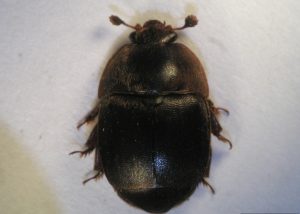
The small hive beetle is a beekeeping pest that originated in sub-Saharan Africa. It has spread to other places including Australia and North America. The small hive beetle is quite destructive in a beehive. It damages comb, pollen, stored honey, and bee larvae. Small hive beetles may also be found in stored comb that has honey. Its larvae tunnels through the comb eating honey and defecating in it. This causes the honey to ferment and discolor.
Adult small hive beetles are dark brown or black in color. They are about 5 mm in length and live for up to 6 months. The females are generally a millimeter or two longer than male small hive beetles. Both genders of the small hive beetle are of the same width – 3.2 mm. Variances in the sizes of small hive beetles are believed to be due to environmental factors such as the climate and diet. In the warmer seasons, small hive beetles can have 4 to 5 generations in your beehive.
Small Hive Beetle Detection
In an infested hive, the beetles are found just about everywhere. Honeybees are active against the hive beetles and often chase them to the rear of the hive, the bottom board and into crevices in the hive. The bees then try to seal the beetles into the cracks and crevices. Female small hive beetles lay eggs in the cracks and crevices of the beehive where bees cannot access them. The eggs then hatch in 2-3 days. The larva that emerges is white colored. It grows to 10-11 mm and feeds on honey and pollen. It damages comb and matures in 10-16 days.
Small hive beetle larvae pupate in the ground. It leaves the beehive and burrows into the soil near the beehive. The pupa stage lasts 3-4 weeks. Adults that emerge from cocoons in the soil re-enter the beehive to continue the lifecycle. Female adults of small hive beetles mate within a week after emergence from cocoons. The damage small hive beetles inflict on your honeybee colony is primarily from the feeding of their larvae. They tunnel through comb to reach honey and pollen but do not eat the comb.
What are Large Hive Beetles?
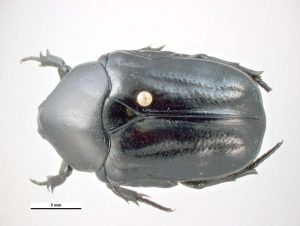
Large hive beetles are scarab beetles found mainly in Africa. They are pests of honeybee brood. The large hive beetle adult is 20-23 mm in length. It has a shiny black body. Large hive beetles do not reproduce inside your honeybee colony beehive. They use herbivore feces and decomposing plant material as their breeding grounds. Adult large hive beetles lay eggs in these environments and development takes place up to emergence of adults from the pupation cocoons. This is a marked difference from small hive beetles whose eggs are laid in the beehive and whose larvae eats honey and pollen in the beehive.
Large Hive Beetle Life-cycle
A large hive beetle life-cycle has 4 stages as typical in insects. Adults of the large hive beetle lay eggs that hatch in 6-10 days. The larvae of the beetles feed on decomposing plant material and herbivore feces for about a month. They grow long and wide. The larvae of the beetle have a red to brown head, and a whitish to cream body. The larvae are white in color but show coloration within their bodies due to the decomposing material they feed on. This coloration is more pronounced at the posterior end of the larvae. After feeding for 30 days, larvae enter the pupa stage which lasts 21-29 days depending on climatic conditions. Adults emerge from the pupation cocoons and may the invade beehives in their search for food.
The damage caused by large hive beetles in a beehive is a result of adult beetles feeding on honeybee brood. Adults show strong preference to the brood when in a beehive. When they cannot reach bee brood, they are noted to eat honey and pollen. Large hive beetles are much larger in size and can quickly eat honeybee brood. This voracious feeding behavior results in quick destruction of comb in the beehive and a rapid fall of your honeybee colony.
Use Small Entrances to Control Large Hive Beetles
Beekeepers in areas where large hive beetles are found can use the large size of the beetles against them. They have small entrances on the beehives that can fit bees but not the beetle. This practice is effective in controlling the beetle. Other more active methods may be used against the beetle if it succeeds in entering your beehive.
How do Hive Beetles Affect the Beehive?

Hive beetles cause a number of problems in a beehive. They make the beehive not very conducive for your honeybee colony.
1. Eating Honeybee Brood
One effect of hive beetles in the beehive is eating your honeybee colony brood. As hive beetles increase in number, their need for food increase. Their favorite source of nutrition in the beehive is bee brood. The result is your honeybee colony getting weakened due to the lowered population of bees. They cannot forage or make enough honey. The hive beetle in the meanwhile get stronger in the hive and their effects on the hive become more pronounced and take place at an accelerated rate. If left unchecked, hive beetles feeding on bee larvae cause the queen to eventually abscond and take the honeybee colony to another location.
2. Eating Honey and Fermenting it
The second way hive beetles in your apiary affect the beehives is destruction of honey. The larvae of hive beetles burrow through honeycomb to reach honey. They do not eat the honeycomb, but make holes in it so they can access stored honey and eat it. After feeding on honey in the beehive, the larvae of hive beetles defecate in the honey. This causes the honey to ferment and give off a bad odor. The honey harvest is ruined and your honeybee colony is deprived of its food. Destruction of stored honey by hive beetle larvae in late autumn can cause your bees to go into winter without enough honey reserves. The colony dies over winter and you have to start over with that beehive in the next season.
3. Stressing the Colony
Bees in a honeybee colony are very busy all the time. They have to forage, clean the hive and care for brood. The bees also have to store up honey for use in winter and on cold days. The queen has to lay eggs to keep the colony strong and well populated. Hive beetles in a beehive distract bees from carrying out these activities. A hive beetle infestation cause the bees to dedicate a large amount of time and worker bee force to round up the pests and keep them away from the brood. This ultimately stresses the bees. If your honeybee colony is not strong enough, the hive begins failing. It requires you to carry out unnecessary feeding of the bees and help the bees fight hive beetles in the beehive.
Small Hive Beetle Treatment Options
Beekeepers dealing with a small hive beetle infestation in their apiaries have at their disposal a number of treatments. The small hive beetle treatments are broadly grouped into those used in the hive and those that are applied on the outside. Honeybees can be affected by most chemicals that affect hive beetles because both are insects. As a result, beekeepers using chemical treatments to control small hive beetles should be very careful to follow application instructions. Additional measures should also be taken by the beekeeper to minimize and possibly eliminate all contact between the honeybee colony and the treatment they use.
Application of pesticides and insecticides carries a risk to the beekeeper too. You should wear adequate protective clothing and have protective gear that prevents the treatments from coming into contact with your body.
Small hive beetle treatments used inside the hive are limited in their number. The treatments that are effective in killing small hive beetles at their adult and larval stages are also good at killing bees. This undesired effect of insecticides and pesticides on bees has resulted in very few treatments being available for in-hive use. Para-dichlorobenzene (PDB) that is often used to control wax moths in empty stored comb is also effective against small hive beetles in stored comb and beehive frames.
1. Coumaphos Small Hive Beetle Killer
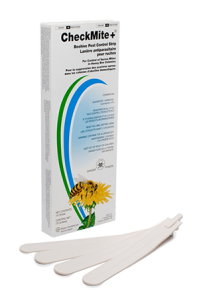
The chemical called coumaphos is the leading treatment available to beekeepers for use inside beehives to control small hive beetles. This chemical is sold under various brand names including CheckMite among others. It is effective against small hive beetles and Varroa mites. A single strip of this small hive beetle treatment is adequate per beehive in your apiary. It should not be used when you are harvesting honey from the beehive. Beekeepers are advised to remove honey super boxes from the beehive during the 42-45 days needed for successful application of coumaphos. It should be allowed to dissipate from the beehive for 2 weeks before honey super boxes are placed on the beehive.
You should at least wear chemical resistant gloves while handling strips of coumaphos. Your leather bee gloves should not be worn as they do not protect you, and may harm your honeybees later. Once you have used this in-hive small hive beetle treatment in the hive, take steps to prevent recurrence of small hive beetle infestations in your apiary. Beekeepers are cautioned against using the treatment more than twice in the same beehive within a year. Read and follow all label instructions that come with your coumaphos treatments.
2. Essential Oils and Boric Acid
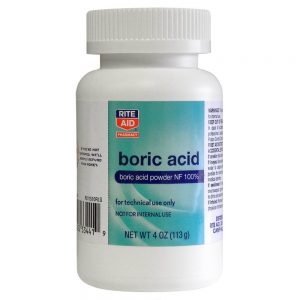
Essential oils and acids can be used in the beehive to control small hive beetles. In later sections of this article, we will take look at wintergreen oil and its uses to control small hive beetles in the beehive. Boric acid has found favor among beekeepers in its application against small hive beetles. A preparation of the acid is used to keep small hive beetles in check. A correx board is required for the job. Boric acid is applied to the inside of a 3 x 4 inch rectangular cutout of the correx board. The ends are then dabbed with shortening or something similar. Small hive beetles are drawn to the shortening. They eat through it and reach the boric acid which kills them. Place the correx board cutouts on the bottom board and secure them with staples or place them on the tops of beehive frames.
Outside the beehive, treatments for the control of small hive beetles are many. They are both pesticidal and biological control methods. The pupa stage in the life-cycle of small hive beetles is vulnerable and is targeted by these treatments. Permethrin is a highly effective pesticide used to drench the soil around beehives. It kills pupa of small hive beetles for up to 90 days depending on soil moisture content, the pH of the soil and the soil type.
3. Permethrin
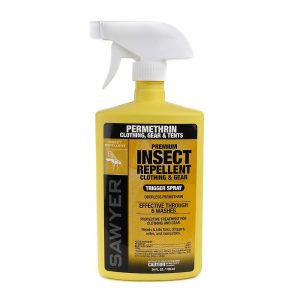
Use permethrin in addition to other soil management practices around your beehives such as covering the ground. Rock, concrete and tar paper can all be used in your apiary to make the ground unsuitable for small hive beetles. Before applying permethrin, clear any vegetation that may be on the ground. This allows the treatment to directly contact and seep into the soil. Additionally, use a sprinkler can to apply the chemical in place of a sprayer. It allows you to apply permethrin without risking the chemical coming into contact with beehive surfaces and harming bees.
Carry out treatments using permethrin during the evening after bees have settled in for the night. Remove any feeding or watering stations for bees from the apiary before applying this small hive beetle treatment. Read and follow the label instructions you are provided with on purchase of a container of permethrin.
4. Nematodes in Small Hive Beetle Control

Small hive beetles can be controlled using entomopathogenic soil-dwelling nematodes, specifically the Heterorhabditis indica. These nematode worms are released into the soil around your beehive in a water suspension. They can be poured onto the soil using a watering can or in a pressurized spray. The nematodes burrow downwards and seek out insects. On finding small hive beetle larvae or pupae, they enter the body of the insects and release bacteria that kill them. The nematodes then reproduce in the mass of insect matter and spread out further in the soil around your apiary.
Using this biological control on small hive beetles poses minimal risk to the environment. Their effectiveness is however relative to certain soil types and they may not survive winters and droughts.
5. Diatomaceous Earth
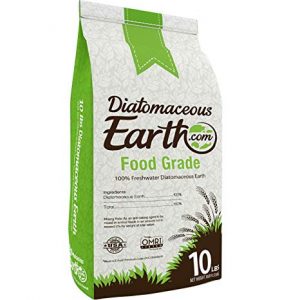
Diatomaceous Earth can also be used to control small hive beetles. It comes in packages of varying weight. Purchase one that is big enough for your apiary. Dust the contents on the ground around your beehives. A radius of 8-10 feet around each hive should be properly covered with the dust. After dusting, water the ground so that it enters the soil. You could also time your dusting of the ground to just before it rains. Diatomaceous Earth kills small hive beetle larvae and pupa in the ground.
Note: The aim of watering is to get the Diatomaceous Earth into the soil where the small hive beetles larvae are located. However, the Diatomaceous Earth will need to first dry before it can be effective against the hive beetles.
Small Hive Beetle Larvae Removal
The larvae of small hive beetles are fond of clustering on beehive frames and in corners within the beehive. They also move towards light when they are older. This is because they want to get out of the beehive and drop to the ground to pupate. These two characteristics are used by beekeepers to remove small hive beetle larvae. It allows you to save beehive frames and be able to use them again in the beehive.
1. Using Light
A light source near the floor or entrance of your beehive draws small hive beetle. You then sweep up the larvae around the light and drown it is water to which you have added some soap.
2. Using Chickens
The second way beekeepers remove small hive beetle larvae is taking infested frames out of the hive and hanging them in a chicken coop. Larvae drop to the ground in the coop and are eaten by chicken. This kills off the larvae without allowing them to pupate. Giving chicken the frames to peck at the larvae is also possible. However, the chicken will ruin already formed comb on the frames.
3. Freezing Frames
Thirdly, you could remove infested frames from your beehives and freeze them. The recommended period of freezing for small hive beetle larvae removal is 4 days. This kills all the larvae on the frames and you can then wash them off the frames.
After small hive beetle larvae removal from beehive frames, take steps to kill off adult beetles that may still be in the affected beehives. You may uncap frames that have had larvae on them and allow bees to eat up the honey. Make sure to wash the frames to remove slime before reusing them in the beehive. Place slimed frames over fire ant mounds if there are any around your area. The ants clean off the slime without messing with drawn comb.
Small Hive Beetle Bait
Trapping small hive beetles is a sure way to control infestations. Adult small hive beetles congregate in dark areas of the beehive. A screened bottom board causes the beetles to move to the upper sections of the beehive. It is best to use a solid bottom board when trapping small hive beetles. Attracting small hive beetles to traps is done using bait. The bait mimics honey and draws the adult beetles. Liquid bait is best for small hive beetle traps.
Traps used to control small hive beetles have small entrances that allow beetles in but are not big enough for bees. Most small hive beetle traps use oil to suffocate the trapped beetles. The bait used in these traps does not contain oil. The traps target small hive beetles entering the beehive, those in the hive, and larvae leaving the hive to pupate. However, not all small hive beetle traps use bait. Those without bait mimic hiding spaces for the beetles. Bees may chase small hive beetles around the hive and they hide in the traps since they are inaccessible to bees.
Small Hive Beetle Bait Recipe
Trapping small hive beetles may require the use of bait to lure the pests into the trap. Bait is available for purchase from various manufacturers, but you can also make your own. Commercially prepared bait has its benefits over home-made bait. However, time and cost often lead beekeepers to make their own bait. With practice, you will make great bait that works better than commercial small hive beetle bait. Here is a simple small hive beetle bait recipe used by beekeepers.
Steps:
- Mix 1 cup of water with ½ a cup of apple cider vinegar and ¼ cup of sugar.
- Add the chopped pieces of 1 ripe banana peel.
- Allow this mixture to ferment and then sieve out the chopped banana pieces.
- This bait is then ready for use in your small hive beetle traps.
Using Wintergreen Oil for Small Hive Beetles

Wintergreen oil is an essential oil that is very popular in beekeeping. It is used in controlling Varroa mites, tracheal mites and small hive beetles in beekeeping. The application of wintergreen oil with an aim to control small hive beetles can be done in various ways. The best is using the oil in traps. It blocks spiracles on the hive beetles and suffocates them to death. Wintergreen oil can be prepared to treat small hive beetles using two methods:
Method 1
- Prepare your wintergreen oil by mixing 1 oz of wintergreen oil with 16 oz of vegetable shortening.
- Mix the two well and then soak a cardboard coaster with the mixture.
- Use one 3-inch coaster per brood box you have.
Method 2
An alternative preparation that uses wintergreen oil to eliminate small hive beetles from your beehives is dabbed onto frames. With this preparation, you mix sugar, vegetable shortening, honey and wintergreen oil.
- The proportions are 4 oz of sugar, 1.6 oz vegetable shortening and 1 oz of honey with .17 oz of wintergreen essential oil.
- Mix the ingredients well without using a mixer or heating.
- The preparation is then applied onto a few frames and the corners of your beehive boxes.
- This preparation is enough for 10 beehives. It clears your beehives of small hive beetles within 2-3 weeks.
How it Works
The wintergreen oil kills the small hive beetles and makes them leave the beehive. Treat all the beehives in your apiary with this preparation of wintergreen oil for best results. If you leave some hives untreated, the small hive beetles may enter those hives once driven out of the beehives where you apply the wintergreen oil preparation.
Using Swiffer Sheets for Small Hive Beetles
Swiffer sheets are great for trapping small hive beetles. They may tangle up a bee or two but can catch the beetles in large numbers. These pads are normally used to wipe dust from surfaces in your home but have found use as homemade small hive beetle traps.
Steps
- Purchase Swiffer sheets and cut them up into squares or strips of 3 x 3 inches each. Unscented Swiffer sheets are the best for this job.
- The cut Swiffer sheets are then are placed on the tops of beehive frames.
- Make sure to spread the cut Swiffer pads out onto all the beehive boxes you have.
How it Works
Bees pull at the Swiffer sheets in an attempt to remove them from the hive, which causes them to fluff up. As small hive beetles go through the sheet, they get trapped, but the bees are too big to get trapped. Being trapped in the Swiffer sheets prevents the small hive beetle adult females from laying eggs. The trapped beetles also eventually die in the Swiffer sheets. Replace the Swiffer sheets that are full of trapped small hive beetles. To prevent bees getting caught, use a screen mesh that allows beetles to enter the sheet but keeps out bees.
Using Dryer Sheets for Small Hive Beetles
Dryer sheets are made for wiping up spills and dust. Beekeepers have found that they can also be used to keep small hive beetle populations low in the beehive.
Steps
- Purchase dryer sheets and cut them into strips or squares measuring about 4 x 4 inches.
- Place the dryer sheets in the inner cover of your Langstroth beehive.
- In an apiary, make sure to have enough of the sheets so you can use them in all beehives simultaneously.
- You could also try placing the sheets on top of frames in various beehive boxes.
How it Works
Small hive beetles get chased by bees in the hive and hide in the areas you have placed your dryer sheets. The beetles get tangled up in the sheets and cannot leave. These sheets may trap a bee or two, but that is an acceptable loss. Small hive beetles trapped in dryer sheets die of starvation and do not get a chance to lay eggs in the beehive. This reduces the population of small hive beetles in the beehive very fast.
When used over a long period of time, you can successfully clear the beetles from your apiary using this method. It is reusable without risk of the beetles developing resistance to it unlike the use of pesticides. Use a screen mesh over dryer sheets to reduce the incidences of bees getting caught in the dryer sheets.
Organic Treatment for Hive Beetles
Controlling small hive beetles is possible using organic treatments. These range from traps to mixtures that you can prepare at home. Small hive beetle control mixtures use essential oils and vegetable oil in them. Mineral oil is used in traps to kill the beetles. Other organic treatments for hive beetles include the use of Diatomaceous Earth. Hydrated lime is used in an organic treatment for hive beetles when it replaces the vegetable oils used in the traps. Lime has a kill ratio that is higher than that of oils. It also spreads out evenly unlike oil that may settle in the lower spots of traps and leave some other spots dry.
In addition to direct control methods, beekeepers should have preventive measures they use in their apiary pest management regimes. These include cleaning the beehive, making sure all beehive parts are in top condition and placing the beehives in sunlight. Having the morning and evening sun hit the beehive makes the beehive warm. Small hive beetles do not like the warm beehive and get out. You may provide shade for your beehives in the mid-day when the sun is strongest.
Do Hive Beetles Die in Winter?
The four seasons of the year have varying effects on small hive beetles. Beekeepers want to use the seasons against small hive beetles. The warmth of summer is great for small hive beetles. They are able to reproduce quickly and build their numbers into the thousands in a beehive within a short time. This continues through spring and autumn. There is plenty of food for the beetles and they often spread to other beehives in the area if left unchecked. An adult small hive beetle can fly up to 7 miles from one beehive to another. Adult small hive beetles live for up to 6 months.
In winter however, the tide turns against small hive beetles. The cold of winter makes them cease reproduction. The adult beetles in a beehive overwinter with bees. Old small hive beetle adults may die in winter but the most recent adults to come from pupation will survive winter. They form the seed population for the next years’ infestation.
Conclusion
Pests of honeybees are destructive and ultimately lead to losses in beekeeping. Controlling these pests such as hive beetles requires beekeepers to put in place strong pest management practices. Preventing pests is better than dealing with their effects and countering the effects they have on honeybee colonies. Small hive beetles destroy comb and feed on resources meant to be used by bees. The large hive beetle is a direct threat to your honeybee colony due to its feeding on bee brood. Use these detailed methods on how to get rid of hive beetles to save your bees from having to endure a hive beetle infestation and its negative effects.
References
- https://bee-health.extension.org/managing-small-hive-beetles/
- https://www.youtube.com/watch?v=-QE2FhIVNTI
- https://beeaware.org.au/archive-pest/small-hive-beetle/
- https://catalog.extension.oregonstate.edu/em9143/html
- https://www.arbico-organics.com/category/small-hive-beetle-control
What method(s) do you use to get rid of small and large hive beetles? How effective were they? Leave a comment below and let us know.
 BeeKeepClub Resources and Guides for Beekeepers
BeeKeepClub Resources and Guides for Beekeepers

we start to do regularly cleaning hive
Yes that helps immensely.
What is cortex board?
Hello, thanks for pointing that out. It’s a typo – it should be ‘correx’ board.
Hello, what is a correx board and what do you mean by putting a screen oner the swiffer/dryer sheets?
Hello.
A correx board is basically a thin piece of cardboard. Check this image here
By screen, I mean a mesh with holes that are small enough to allow hive beetles to pass through, but not the honey bees.
How long should the towels remain in the hive or will the bees eventually remove them? Can they be left in with the honey supers on?
You mean the sheets? Leave them as long as is necessary to get the desired results. This is a non chemical method so it can be used with the honey supers on.
I mixed the ingredients and soaked the blue towels. They dripped out overnight on some hardware cloth. Today they still had a lot of oil in them, so I squeezed them some and released the liquid. I was concerned that the oil would drop out on the bees. Did I need to ring them out or should I have placed them in the hive with the additional oils in them? So, this treatment is for the brood boxes only or can I use them throughout the colonies’ hive boxes? Will the honey be tainted from the aroma of the essential… Read more »
Hi Jim,
Try leaving the cloth in (don’t squeeze it out) for a week or two and check the results.
Also, if you’re going to apply oils, then it’s highly recommended to remove honey supers when conducting any treatment on your beehives.
Hive Beetle Treatment Recipe
1 Gal. Canola Oil
100 ml each of Eucalyptus, Camphor, and Teatree oils
4 rolls of Blue Shop Towels (cut in half) to make 8 rolls
===== Instructions for Application==
Mix oils and soak up oils with towel rolls.
Let excess oil drain away over a screen or colander
1/2 sheet per Deep Hive Box across the top bar
Recipe from Blue Ridge Honey Company – Bob Binnie
Johnny Ritchie
Honey Bee Rescue of South Florida
Hi Johnny,
Thanks for sharing this recipe!
I am a bit confused about the advice to water diatomaceous earth into the ground around the hive. As a gardener new to keeping bees, I’ve always been told that wet diatomaceous earth is ineffective for killing various soft-bodied insects, at least those that are garden pests. I have a ton of food-grade diatomaceous earth. Can you confirm for me that you really do water it into the ground?
Also, is there a specific type of beneficial nematodes that is particularly effective against small hive beetles?
Hi Diane,
Thank you for your comment.
It wasn’t clear in the article but the point of watering the diatomaceous earth is so it can get to the hive beetles underground. You are correct though, as the diatomaceous earth will need to dry first before it can take effect.
As for the nematodes, the specific type are the Heterorhabditis indica.
Thanks for your quick answers! I guess it wouldn’t hurt to try watering in the DE; then, if the ground dries out when it’s really hot and dry here (which it hasn’t been this summer, but is in some summers), maybe it will do some good. I wonder if it would kill the nematodes if I got them, though. I may try the DE this summer, then get the nematodes next spring if I’ve still got the problem.
I would recommend either the DE or the nematodes at a time, not both.
When you say dryer sheets are you talking about what we use in a dryer. I have never used them for picking up spills or for dusting. If so do you use them new or after using in the dryer?
Hello Eddie,
You use the dryer sheets new. The purpose of the sheets is to trap the hive beetles inside them.
You mentioned soaking a coaster in wintergreen oil mixed with vegetable oil. Is this a standard cardboard coaster used in bars? Then what do you do with it? How is it placed/used in the hive to reduce beetle numbers?
Hi Shari, yes this is a standard cardboard coaster. You would place it between the frames. When the beetles get into contact with it, they will die off.
You can remove a lot of beetles at once with this process: Ask someone to help you inspect the hives. Put a large hard surface near the hive (like an extra hive cover). As you inspect a frame, rest one corner of the frame on the hard surface. Tip the frame so that the beetle-occupied-side is facing downward, and puff smoke onto the beetle. After 3 or 4 quick smoker puffs the beetles just roll out. And the person helping you squashes them with a hive tool. You have to be quick. If you hold the frame too high up… Read more »
Thanks for sharing!
[…] are various methods available to beekeepers to control hive beetle populations in their beehives. Hive beetles can fly from a single hive and spread to the entire apiary, as such, they are a nuisance that must […]
[…] from. To find out in the event that they used chemical compounds for pest remedy, how varroa mites, hive beetles, and wax moths have been monitored, and to find out in the event that they ever had honeybee […]
Does one leave the traps in during the winter?
Yes you can, especially if you’re having issues with them.